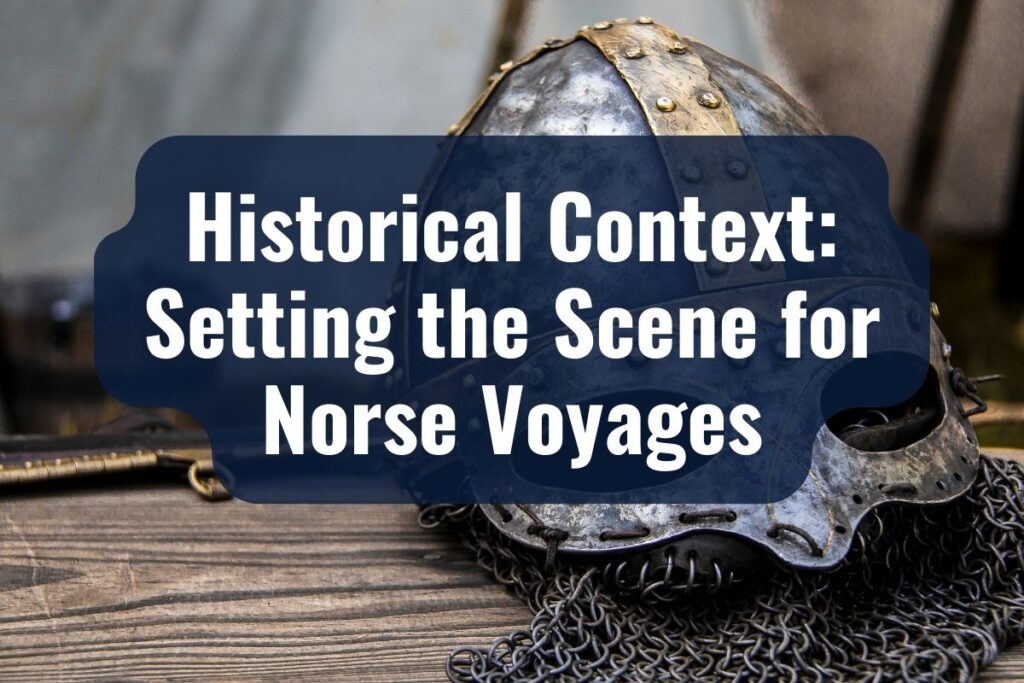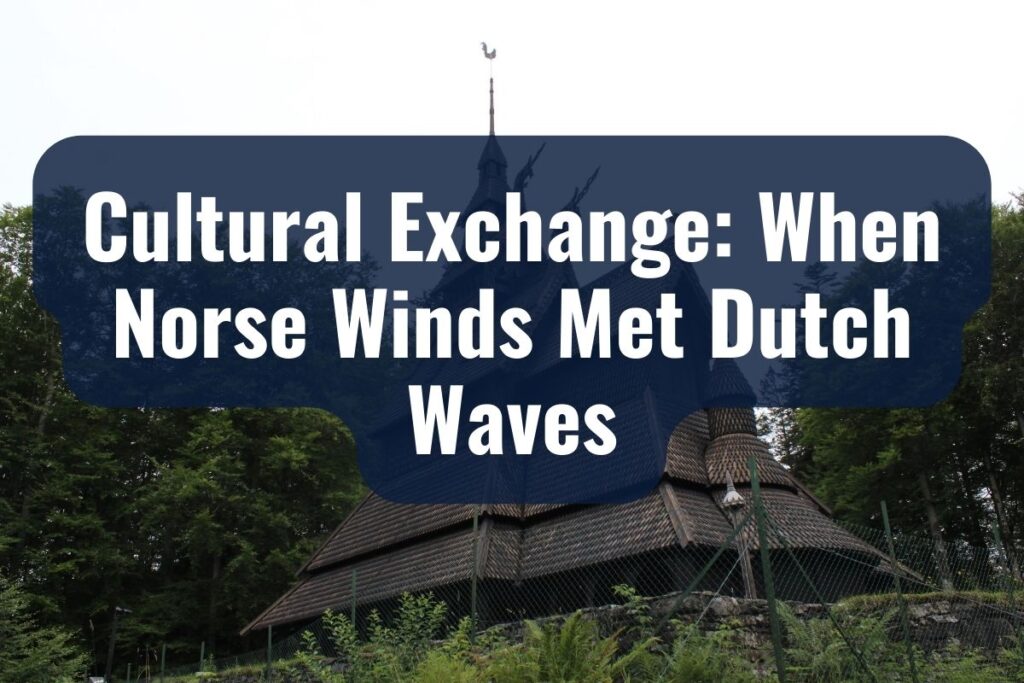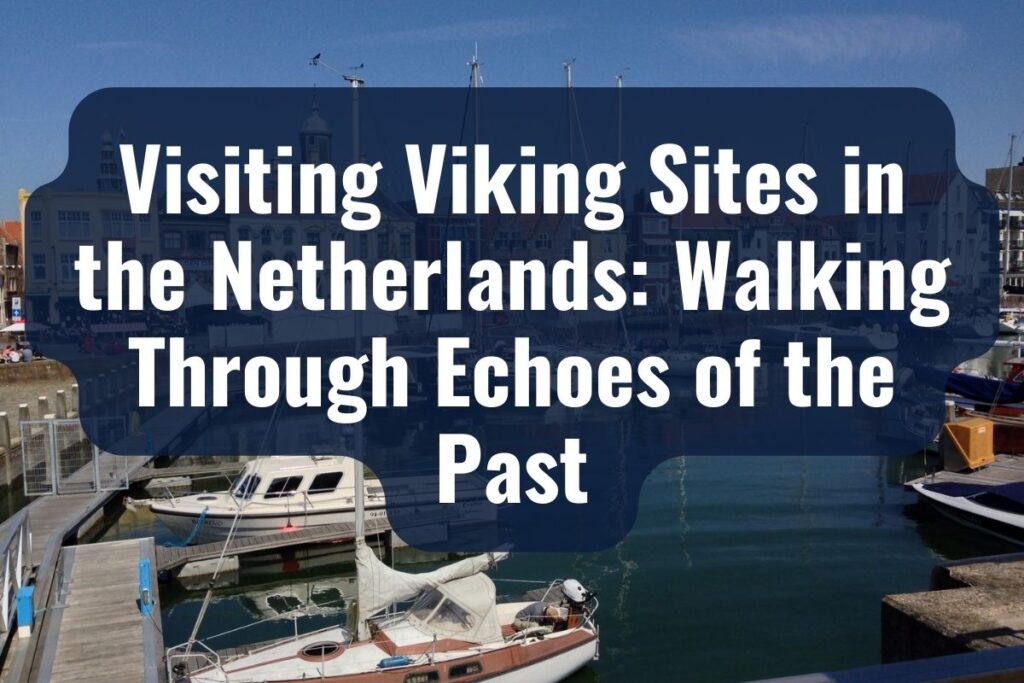Picture a cold, misty morning along the rugged coastline of the Netherlands. The peaceful lapping of waves is suddenly interrupted by the unmistakable silhouette of a Viking longship, its dragon prow cutting through the fog. As the ship approaches, the haunting melody of Norse songs fills the air. The Vikings have arrived.
For many, the very word “Viking” conjures images of horned helmets, fearsome warriors, and tales of distant lands. But how often do we associate these Norse seafarers with the tulip-adorned, windmill-studded landscapes of the Netherlands? The truth is, the stories of Vikings and the Dutch are deeply intertwined, a saga of exploration, trade, and cultural exchange that has left an indelible mark on both societies.
In this journey through time, we will uncover the fascinating tales of Viking activities in the Netherlands, dispel myths, and illuminate the rich tapestry of shared history. Whether you’re a curious tourist, an expat eager to understand your new home, or a student of history, prepare to be captivated by the enigmatic legacy of the Dutch Vikings.
Key Takeaways:
- The Vikings had a multifaceted presence in the Netherlands, encompassing trade, settlement, and cultural exchange.
- Norse activities in the Dutch lands went beyond raiding, with major centers like Dorestad becoming trade hubs.
- The interaction between Vikings and Dutch led to a vibrant mutual exchange of traditions, beliefs, and practices.
- Legendary figures and narratives, both Dutch and Viking, enriched the historical tapestry of their intertwined tales.
- Tourists and history enthusiasts can immerse themselves in the Viking era by visiting key sites across the Netherlands.
Misconceptions and Clarifications: Unraveling the Norse Knot
The world of the Vikings, while enchanting, is often shrouded in myths and misunderstandings. Our perceptions, molded by popular culture and dramatic retellings, sometimes drift away from historical accuracy. The story of the Vikings in the Netherlands is no exception. So, before we sail deeper into this captivating narrative, let’s anchor ourselves in facts and dispel some common misconceptions.
Vikings vs. Danes
One of the most frequent mix-ups involves equating the Vikings solely with the Danes. While it’s true that Denmark was a Viking powerhouse, the term “Viking” refers more broadly to the seafaring Norse people, which included not only Danes but also Norwegians, Swedes, and other Scandinavian tribes. These adventurous souls ventured far and wide, with the Netherlands being one of their many destinations.
Were There Really “Dutch Vikings”?
This is a question many ponder. The term “Dutch Vikings” might suggest a distinct group of Norse settlers native to the Netherlands. In reality, the term reflects the Norse settlers, traders, and raiders who integrated, lived in, or influenced the Dutch territories. Over time, their interactions with local communities led to a blend of cultures, but they weren’t “Dutch” by origin.
Vikings: Just Raiders and Plunderers?
While stories of Viking raids are legendary and were undoubtedly a part of their history, it’s essential to recognize their equally significant roles as traders, explorers, and settlers. In the context of the Netherlands, the Vikings established trading hubs, built alliances, and even settled in certain regions, making their relationship with the Dutch multifaceted and profound.
The Horned Helmet Myth
It’s almost impossible to picture a Viking without imagining a horned helmet. However, historians and archaeologists have found little evidence to suggest that Vikings wore such helmets. This popular image is more a creation of 19th-century romanticism than historical fact. So, while it adds drama and flair to our visualizations, it’s a tad away from the truth.
Historical Context: Setting the Scene for Norse Voyages

To truly grasp the depth of the Vikings’ influence in the Netherlands, one must first understand the era’s tapestry in which their tales are woven. The Viking Age, spanning from the late 8th to the early 11th century, was an epoch of discovery, ambition, and change, not just for Scandinavia but for all of Europe. As we step back into this vibrant age, we’ll uncover the backdrop against which the Norse sagas in Dutch lands unfolded.
The Dawning of the Viking Age
It began with a raid. In 793 AD, the Vikings made their dramatic debut on the European stage with an attack on the Lindisfarne monastery in England. This event didn’t just herald the start of Viking expeditions; it signaled a shift in European geopolitics. From this point on, no coastal region in Europe was safe from the prospect of a Norse longship appearing on the horizon.
The Allure of the Netherlands
The Low Countries, with their intricate network of rivers and fertile lands, were more than just attractive for raids. The Netherlands, positioned strategically at Europe’s heart, was a hub for trade, offering the Norse opportunities for commerce, settlement, and cultural exchange. Its landscape was dotted with thriving towns, rich monasteries, and bustling markets, all beckoning with promise.
Socio-Political Landscape of the Netherlands
During the Viking Age, the Netherlands wasn’t a unified nation as we know it today. Instead, it was a patchwork of territories governed by local chieftains and lords. These territories, with their unique cultures and governance, provided both challenges and opportunities for the incoming Norsemen. Some areas saw Vikings as threats, while others welcomed them as traders and potential allies against rival factions.
The European Response
The Vikings’ presence wasn’t met with passive acceptance. Throughout Europe, kingdoms fortified their defenses, and the Dutch regions were no exception. Coastal monasteries built walls, towns established militias, and alliances were forged. But alongside conflict, there were also tales of collaboration, intermarriage, and shared endeavors.
Viking Activities in the Netherlands: Trade, Settlement, and Saga
The image of a Viking longship landing on Dutch shores captures the imagination, but the depth of their activities in the region goes far beyond mere raids. From bustling trade hubs to lasting settlements, the Vikings left an indelible footprint in the Dutch landscape, weaving tales of commerce, exploration, and shared ambitions.
Trading Hubs and Flourishing Markets
Vikings were not just warriors; they were astute traders with an eye for lucrative opportunities. The Netherlands, with its central European location, became a vital node in the Norse trade network. Dutch ports like Dorestad quickly became major centers of commerce where Norse goods such as amber, pelts, and whale bone were exchanged for Frankish silver, textiles, and wine.
Notable Settlements and Their Legacy
Beyond trading, Vikings found the fertile lands of the Netherlands appealing for establishing settlements. Over time, some Norsemen chose to stay, integrating with local communities. Walcheren, in Zeeland, is a notable example, where evidence suggests a strong Viking presence. These settlements weren’t merely transient; they birthed towns and influenced local architecture, governance, and even daily life.
Archaeological Treasures Tell a Tale
The Dutch soil has, over the years, yielded numerous artifacts that bear witness to the Norse presence. From intricately crafted jewelry to weapons and runestones, these finds offer a tangible connection to the past. Particularly noteworthy is the Viking silver hoard discovered in Wieringen, a testament to the region’s importance in the Norse trade circuit.
Friend or Foe? The Dual Nature of Norse Interaction
While trade and settlement played significant roles, it’s essential not to overlook the more turbulent interactions. Raids on wealthy monasteries or strategic locations did occur, leading to periods of tension. However, these conflicts often morphed into alliances, as local chieftains saw the benefit of having Norse warriors by their side in regional skirmishes.
Cultural Interweaving
As the Vikings traded, settled, and interacted with the Dutch, a mutual exchange of traditions and practices ensued. Norse festivals found a place in Dutch calendars, while Viking chieftains sometimes adopted local customs. This melding of cultures birthed a unique blend that enriched both societies.
Cultural Exchange: When Norse Winds Met Dutch Waves

In the intricate dance of history, few things are as mesmerizing as the blending of cultures. The Vikings and the Dutch, with their shared stories of trade, settlement, and occasional conflict, didn’t just coexist; they enriched each other’s lives through a vibrant exchange of traditions, beliefs, and practices. This fusion crafted a unique tapestry that tells of mutual respect, adaptation, and shared destinies.
Dutch Influences on the Viking World
Language and Lexicon: As the Vikings settled and traded, they picked up Dutch words, enriching their own vocabulary. Some Norse terms, especially those related to trade and navigation, have roots in the Dutch language.
Art and Craftsmanship: The Dutch were known for their intricate craftsmanship, especially in textiles and ceramics. Vikings, impressed by these skills, often incorporated Dutch techniques into their own artistry, leading to hybrid designs that were both functional and beautiful.
Architectural Inspirations: Norse settlements in the Netherlands gradually began to show Dutch architectural influences, especially in the construction of homes, storage spaces, and public buildings. The Dutch penchant for using bricks and certain roofing techniques found their way into Viking designs.
Viking Influences on Dutch Society and Culture
Narratives and Sagas: Vikings were not just warriors and traders; they were storytellers. Their sagas, rich with tales of gods, heroes, and adventures, captivated the Dutch imagination. These stories, passed down through generations, found their way into Dutch folklore and oral traditions.
Festivals and Celebrations: Some Norse festivals, celebrating seasonal changes, valor, or deities, resonated with the Dutch and were integrated into local celebrations. Over time, elements of Viking festivities merged with Dutch traditions, creating unique celebrations.
Jewelry and Personal Adornments: The distinct Norse style of jewelry, characterized by its intricate designs, animal motifs, and use of metals, influenced Dutch fashion. Items like brooches, arm rings, and necklaces became popular, merging Norse aesthetics with Dutch sensibilities.
Shared Culinary Traditions
While the diets of the Norse and the Dutch had distinct differences, there was a notable exchange in culinary traditions. Dutch breads, cheeses, and brewing techniques intrigued the Vikings, while the Dutch adopted some Norse methods of preserving fish and meat.
Key Characters and Legends in Dutch Vikings: Luminaries from a Time Long Past
In the vast theater of history, it’s often the legends and personalities that capture our collective imaginations. The intertwining tales of the Vikings and the Dutch are no exception. Amidst the annals of trade, settlement, and cultural exchanges, there were individuals and legends that stood out, casting long shadows across the tapestry of time. These are their stories.
Ragnar Lothbrok
While the historicity of Ragnar is debated among scholars, his legend is undeniable. Often depicted as a legendary Norse hero and king, Ragnar’s purported raids on France are well-documented. While his direct interactions with the Dutch territories remain a subject of research, the tales of his journeys, bravery, and cunning tactics have certainly influenced Norse sagas recounted in the region.
King Godfred
A historical figure of the 9th century, King Godfred of Denmark sought to control the Frisian trade, which inevitably led him to the bustling markets of the Netherlands, particularly Dorestad. His ambitions in the region paint a vivid picture of the political and economic interests Vikings held in Dutch territories.
The Legend of the Lady of Stavoren
A tale deeply rooted in Dutch folklore, the Lady of Stavoren speaks of a wealthy widow from the town of Stavoren who, in her quest for unimaginable riches, inadvertently brings ruin upon her city. While the story is intrinsically Dutch, elements of Norse storytelling, with its rich tapestry of pride, downfall, and moral lessons, can be seen interwoven.
Sigrid the Haughty
While primarily associated with Sweden and Poland, the tales of Sigrid—a fierce and independent queen known for her uncompromising nature and strategic alliances—would have been known to Viking settlers and traders in the Netherlands. Her stories, which encompass diplomacy, warfare, and personal vendettas, resonate with the broader themes of Viking narratives.
Local Chieftains and Norse Leaders
Beyond the legends that have survived the ages, there were countless local leaders, both Dutch and Viking, whose tales might have been lost to time but were crucial in shaping the day-to-day interactions. Stories of friendships forged, rivalries ignited, and families united through marriage would have been the talk of towns and settlements, narrating the micro-histories of Viking-Dutch dynamics.
Visiting Viking Sites in the Netherlands: Walking Through Echoes of the Past

There’s an incomparable magic in standing on grounds once graced by ancient feet, feeling the whispers of bygone days and witnessing history’s silent testament. The Netherlands, with its lush landscapes and deep-rooted history, offers myriad opportunities for history enthusiasts, tourists, and the curious to step back into the Viking Age. So, if you’re yearning for a Norse-themed adventure, here are some must-visit locales where history springs to life.
| Site | Location | Significance |
| Wieringen | Den Oever | Viking silver hoard and settlement evidence. |
| Dorestad (modern-day Wijk bij Duurstede) | Wijk bij Duurstede | Once a thriving trading hub frequented by Vikings. |
| Walcheren | Zeeland | Strong evidence of Viking presence and activities. |
| National Museum of Antiquities | Leiden | Houses Norse artifacts discovered in the Netherlands. |
| Ribe Viking Center (Outside NL) | Denmark | Immersive Viking experience with reenactments. |
Wieringen
An unassuming rural region today, Wieringen was once a vital Viking settlement. The discovery of the Viking silver hoard here not only testifies to its historical significance but also makes it a primary site for Viking enthusiasts. The local museum in Den Oever houses these artifacts, showcasing a slice of the rich Norse legacy.
Dorestad (modern-day Wijk bij Duurstede)
Once a thriving trading hub that beckoned Vikings from far and wide, Dorestad offers more than just historical allure. As you wander its streets, the echoes of bustling markets, trading chants, and perhaps even the distant sound of a Viking horn might just fill your imagination. The town’s museum offers invaluable insights into its Viking-era past.
Walcheren, Zeeland
Evidence of Viking presence is strongly etched in this region. With its coastal charm, Walcheren provides not only historical context but also a serene backdrop for reflection. The intertwining tales of Norse sailors and Dutch locals are palpable in the very air of this quaint locale.
The National Museum of Antiquities, Leiden
While not a site of Viking settlement, this museum is a treasure trove for those seeking to immerse themselves in Norse artifacts discovered in the Netherlands. From weaponry to jewelry, the collection paints a vivid picture of Viking life, trade, and artistry.
Ribe Viking Center, Denmark
While this is not in the Netherlands, no Viking journey would be complete without visiting Ribe, the oldest town in Denmark. An easy trip from the Netherlands, the center offers an immersive Viking experience, from workshops to reenactments. It provides invaluable context to the Viking tales rooted in the Dutch lands.